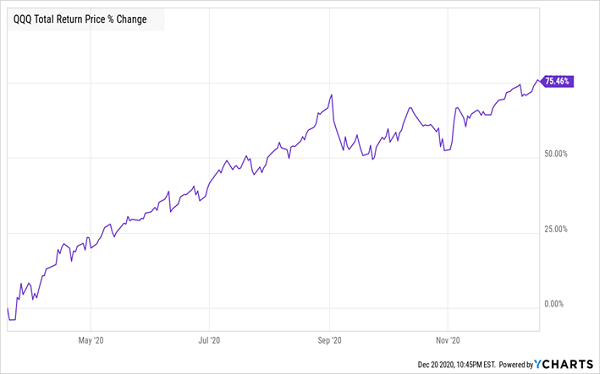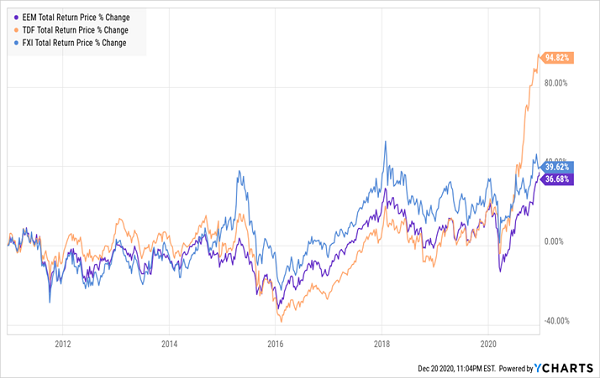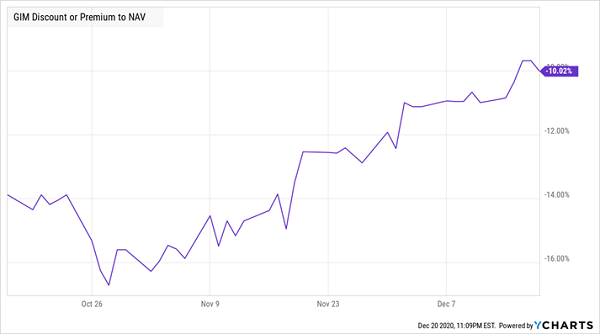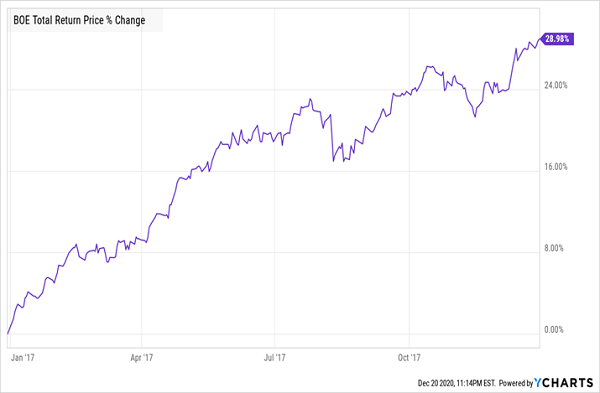As contrarians, we know we need to buy when everyone’s selling. Because that’s when we get gains like this:
Buying Into the March Crash Was Hard—But It Paid Off

Of course, anyone who sold their stocks in the depths of the March crash learned just how damaging that can be. But if you played the contrarian and bought in March, you did great.
But where should contrarians be shopping today, with US stocks, especially tech stocks, at all-time highs? We’re going to explore beyond big tech and focus on a contrarian hunting ground few investors consider: emerging markets.
One reason why developing economies don’t make it onto most investors’ radar is that they’ve been underperforming: in the last three years, their returns have been a fifth of those of US tech stocks, even as these markets have seen strong growth and technological improvements (especially in less-developed Asian nations).
However, with tech stocks trading at such lofty heights, I expect 2021 to usher in a new trend of investors moving into sectors that are overlooked right now. And emerging-market stocks, with their improved productivity and lower valuations, are perfectly positioned to ride that shift.
One beneficiary would be the iShares MSCI Emerging Markets ETF (EEM), an ETF that invests in a wide range of emerging-market firms. But we can do a lot better when we swap ETFs for emerging-market closed-end funds (CEFs). That’s because CEFs are actively managed, and you need specialized expertise to be successful in emerging-market stocks. That gives human managers an edge over algorithm-driven ETFs, and they often outperform them.
Plus, there are a lot of emerging-market CEFs that have big yields and are worth a look now. Here are three to put on your list, ranked from my least to most favorite.
Emerging-Market CEF No. 1: Templeton Dragon Fund (TDF)
First up is the Templeton Dragon Fund (TDF), in orange below, which has lapped (and then some) the emerging-market index (in purple) and the China-focused iShares China Large-Cap ETF (FXI), in blue.
Soaring Past the Alternatives

TDF can do this because it has boots on the ground: its deep research abilities in China help it avoid weaker companies and focus on the real winners with reliable profit potential. And despite its strong performance, TDF trades at an 8.4% discount to net asset value (NAV, or the value of the stocks in its underlying portfolio).
One of the reasons it’s overlooked is that TDF pays out just two special dividends per year, and its payouts can vary by quite a lot. This sometimes translates into crazy yields, such as the 23% yield you can extrapolate from the fund’s most recent payout. But usually with this fund, a big yield one year turns into a much more reasonable yield the next year. That can disappoint investors and increase the fund’s discount to NAV.
Which brings me to our second emerging-market CEF pick.
Emerging-Market CEF No. 2: Templeton Global Income Fund (GIM)
If you’re searching for more consistent dividends, I’d suggest taking a close look at TDF’s sister fund, the Templeton Global Income Fund (GIM).
GIM’s track record isn’t as impressive as TDF’s, but its 3.7% yield and 10% discount to NAV set it up for gains with a resurgence in interest in emerging markets. In the last few weeks, investors have begun to notice GIM’s potential, which is why its discount has been rapidly dwindling. (This, by the way, is my favorite time to buy a fund: when its discount has bottomed and is in the initial phase of moving sharply higher.)
GIM’s Discount Forms a Bottom, Then Takes Off

With a portfolio spanning the globe (including major holdings in South Korea, Mexico, Japan, Norway and Indonesia), this fund is specifically positioned for a rise in US spending on imports, which I expect to see next year, along with a stronger US dollar.
Emerging-Market CEF No. 3: BlackRock Enhanced Global Dividend Trust (BOE)
If you want a yield that’s higher than GIM’s 3.7%, take a look at the BlackRock Enhanced Global Dividend Trust (BOE), which yields an outsized 7.1%. It also trades at a 12.3% discount to NAV. And BOE is almost always a leader when investors turn their attention to emerging markets, like they did in 2017:
BOE Rode the Last Emerging-Market Shift to a Fast Return

With this fund, you can buy now and collect your 7.1% dividend (paid monthly) while you wait for more investors to catch on to the gains waiting for them in emerging markets. That makes BOE a fund more than worth your consideration as 2021 dawns.
These Ignored Funds Have Made Money 99% of the Time (and yield 7.5%+)!
Big dividends like the one BOE pays are just one reason to like CEFs. Another is that these funds have more than proven themselves as steady profit (and dividend!) generators in all market weather.
In fact, my latest research revealed a startling fact about the oldest CEFs: they have an incredible record of turning a profit!
Get this: of the 330 CEFs that are a decade old (or older), only 14 have lost money in the last 10 years.
That’s a 96% win rate!
There’s more: of the 14 CEFs that did lose money, 11 were in the energy sector. Dump those 11 laggards and these CEFs’ win rate jumps to an incredible 99%!
And because these statistics include dividends, you’re getting much of your return in safe cash, not here-today, gone-tomorrow paper gains.
No wonder thousands of Americans are leaning on CEFs for retirement! And today is your chance to join them with my top 5 CEF buys for 2021.
Between them, these 5 income powerhouses throw off a 7.5% average dividend, and that’s just the average! The highest payer of these 5 pays a massive 9% dividend as I write this.
I’m ready to share everything I have on all 5 of these 7.5%-paying CEFs with you now. Go right here to get their names, tickers, buy-under prices, complete dividend histories and everything else you need to know.

Recent Comments